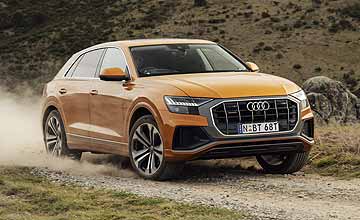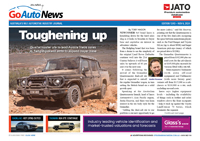Make / Model Search
OptionsCar reviews - Audi - Q8 - 55 TFSIAudi modelsOur OpinionWe like Beautiful cruising ride comfort, superb build quality, fascinating MMI performance, stylish looks Room for improvement Hesitant engine response, average performance, sensitive adaptive cruise, less room than Q7 Coupe styling and luxury features lift Q8 55 TFSI to a higher rung on Audi’s ladder9 Jul 2020 By NEIL DOWLING Overview
LUXURY, performance, safety and bling meld into Audi’s latest niche SUV that adds another sliver of model range above the stalwart Q7 while giving status-seeking Audi aficionados a reason to stay loyal.
The Q8 adds another number to the four-rings’ SUV range and yet the newcomer is steeped in inconsistencies while its audience is easily distracted by similar offerings from all the big European names.
The elephant in the room is the Q7, the Q8’s sibling that now has been relegated to the workhorse end of the Audi model range and into the shadow of the new SUV that clearly appeals to buyers wanting style over function.
Drive Impressions
You know you’re not going to be surprised about the high price of a new luxury SUV and Audi’s Q8 doesn’t disappoint. The 55 TFSI (petrol V6) is priced at $129,900 plus costs, and stands up against the best of offerings from Britain, Germany and Italy.
The Q8 55 TFSI is the petrol-engined rival to an enthusiastic bunch of like-minded spirit drinkers including the Maserati Levante 350 ($125,000), Porsche Cayenne Coupe ($134,100), Land Rover Range Rover Velar 380 HSE ($122,172), Mercedes-AMG GLE43 Coupe ($145,470) and BMW X6 40i ($126,900).
That’s an impressive roomful of rivals that appeal to high disposable-income users based on exclusivity of name and distinctive styling reflected in the SUV profile.
Then there’s the drive experience dominated by silky and quiet petrol drivetrains that mirror much of the luxury of saloons and a welcome step away from the more agricultural diesel-fuelled equivalents.
There’s no argument that Audi makes quality engines and the Q8 would have held the brand’s flame for a petrol-only range and leave the diesel to sibling Q7.
A change of heart by the company recently sees a diesel 50 TDI version join the Q8 range, so negating the point of difference. The only happy note is that the new oiler gets the same sticker price as the 55 TFSI.
Buyers may also be confused in the marketing pitch of the numerically bigger Q8 actually being physically smaller than the Q7, with only five seats compared with the Q7 at seven.
But it’s not all about pragmatism. The Q8 is the first SUV drawing by new designer Marc Lichte who picked up cues from the Audi Quattro coupe of the 1980s.
The more angular lines and wheel-arch blisters were first shown on the Q8’s concept at the Detroit motor show of 2018 and have now become the signature crisp-edge styling more recently showcased with the A1 through to the Q2 and Q3.
The Q8 gets a more pronounced and defined grille platter with aggressive infill “teeth”, waistline with subtly inflated wheel arches, LED head and tail-lights and the Tonka-toy look of 22-inch wheels (optional with 21-inch standard) that came straight off the design studio floor to give balance and proportion that cleverly hide the SUV’s bulk.
It would be too easy to say the Q8 is a Q7 in a different frock. Sure, they use the same platform and there’s a lot of drivetrain commonality.
On the showroom floor they are chalk and cheese. Despite the numerically bigger name, the Q8 is shorter than the Q7 - by 66mm - and cabin space is a bit tighter thanks to the lower roofline that slopes to the rear in a coupe stance that squeezes rear headroom and cargo volume.
The Q8 will seat five adults, though the rear-seat scalloping shows it is aimed at providing comfort for four occupants. It has a bit more rear-seat legroom than the Q7, primarily because the Q7 is a seven-seater and the Q8 is just for five. Or to be honest, four.
That’s not to say the Q8 won’t deliver on occupant room, though taller people in the rear can come a bit close to rubbing scalps with the headliner.
Pop the electric tailgate and the Q8 looks spacious and, in fact, suited all the purposes used for this test including loading two bicycles, without needing to remove the bike wheels.
But the pretty sloping tail does damage to the volume, showing the Q8 has 605 litres (and 1755L with the rear seat flat) compared with the Q7 at 770/1955L and a more rectangular interior that suits box-shaped items.
Inside there’s a lot of flow over from the rest of the Audi range, particularly A6 and Q5 upwards, but some new gear as well.
For the driver, there’s no twist-and-press central controller for the multi-media interface (MMI) as the functions have been incorporated as tactile controls placed within a black panel. Cleverly, the intense use of piano black within the dash almost completely masks this operations panel.
Some of the vagueness of previous Audi dash graphics has also gone, with simple symbols to identify functions and reduce driver distraction.
The MMI has two screens that are additional to the 12.3-inch virtual cockpit. The MMI visualises its operation through two large centre-console screens - a 10.1-inch touchscreen for navigation and infotainment and beneath that, an 8.6-inch screen for climate control and communication, including text input.
Audi continues with its virtual cockpit layout being rolled out in other models, now standard in the Q8 and offering two choices of instrument panel design which work alongside the head-up display.
Touch controls are haptic so there’s an audible click and a distinctive physical movement as the functions are activated.
Increasing the heat of the HVAC system by pressing the plus button, for example, raises the digital temperature scale with the MMI responding with a confirming tap through the finger.
The Q8 gets top-notch Bang & Olufsen audio with digital radio and 10 speakers but audiophiles may opt for the extra-cost B&O 3D audio unit.
This was included in the test car, bundled with the pretty 22-inch wheels (21-inch are standard), adaptive air suspension, matrix LED headlights (non-matrix LED head and tail-lights are standard) and four-zone HVAC for an extra $11,000.
Off the showroom floor, the Q8 also gets three-zone air, adaptive dampers, electric tailgate, leather upholstery and trim, heated and ventilated front seats, and a surround-view camera.
Safety kit is first rate, opening with autonomous emergency braking with pedestrian detection, adaptive cruise control, lane-departure warning, blind-spot monitor, rear cross-traffic alert, cross-lane warning, door-opening warning for passing cars and bikes, and eight airbags.
The Q8 shares the basic MLB Evo platform with the third-generation Audi Q7, Porsche Cayenne and Volkswagen Touareg, and also the Bentley Bentayga, Lamborghini Urus and the latest Audi A6 and A8 passenger cars.
There’s nothing really new about the drivetrains, with the Q8 getting the ubiquitous EA839 3.0-litre V6 with the single twin-scroll turbocharger rated at 250kW from 5000-6400rpm and torque of 500Nm between 1370rpm and 4500rpm.
It adds a mild hybrid system of 48-volts that makes for a rapid stop-start reboot and allows the SUV to switch off the petrol and coast between 55km/h and 160km/h, picking up power from the 12kW belt-driven alternator (motor) for up to 40 seconds.
Despite the new number on the tailgate, the Q8 takes 500m down the road before revealing itself as distinctly Q7 in ride and handling.
It is lower and slightly heavier - by 10kg to be 2145kg dry - than the Q7 and despite the 250kW output, feels less enthusiastic and even borders on lethargy at low engine revs.
Where the Q7’s diesel is bulk torque and gritty power delivery, the Q8 petrol is a bit wimpy until urged on.
The mass of the Q8 is noticeable on the first corner, while the engine shows a reluctance to quickly build up speed, whether because of the sheer mass of the SUV or some primary training to minimise fuel use and emissions. Switching to the dynamic mode doesn’t make much difference except retain a lower gear.
That characteristic comes as a surprise given the wealth of expertise in developing the Q8’s mild-hybrid 48-volt system that, frankly, doesn’t appear to do much at all except allow extended stop-start intervals and, courtesy of the lithium-ion battery and associated hardware, add weight.
There is some contribution when coasting - claiming savings of 0.7 litres per 100 kilometres - but it’s barely noticeable.
The drivetrain can also frustrate on acceleration from the lights or from low speeds, where the gearbox and engine make out they’re talking different languages and little forward action eventuates.
Dual-clutch gearboxes are known for their annoying hesitancy and lag and Volkswagen Group has a string of these transmissions in use in its models.
Today, we can’t blame the dual-clutch as the Q8 uses a conventional torque convertor auto with eight cogs – so the problem is more with the engine.
Where the Q8 does shine brilliantly is when cruising or when little is asked from the accelerator pedal. It is a superb cruising machine, with the air suspension (with adaptive mode available as an option) soaking every bitumen pimple and the V6 silently ticking over under the hood.
Audi claims 9.2L/100km for the big SUV with this test – from freeway to city to suburbs – averaging a respectable 11.2L/100km, drained from the 85-litre tank that takes a minimum of 95RON.
The only hiccup with cruising is the adaptive cruise control which is easy to operate but the camera-radar in the system and matching autonomous emergency braking is sensitive to traffic in adjoining lanes and often braked to match their speed, despite an open road ahead.
Steering control is as good as electric-assist can be – okay, Porsche does it better but the systems are similar – while braking is outstanding, given the SUV’s size and weight.
Warranty and servicing
All new Audis come with a three-year, unlimited-kilometre warranty, while an optional extended warranty can extend the coverage period for up to an extra 48 months or 160,000km.
Scheduled services are due every 12 months or 15,000km, whichever comes first.
Verdict
Fashion trumps over function with the Q8 looking like a starlet against the more durable styling of its Q7 sister.
The petrol engine is sweet but suffers from low-speed apathy while fuel consumption is surprisingly good and cruising comfort is excellent.
For people who like style over boot space, new tech cabins over analogue dashboards and yet still appreciate top-shelf automotive build quality, the Q8 may be the pick.  All car reviews Alfa Romeo Alfa Romeo Abarth Abarth Alpine Alpine Alpina Alpina Audi Audi Aston Martin Aston Martin BMW BMW Bentley Bentley Chevrolet Chevrolet Chery Chery Citroen Citroen Chrysler Chrysler Dodge Dodge Cupra Cupra Ferrari Ferrari DS DS Ford Ford Fiat Fiat FPV FPV Foton Foton GWM GWM Great Wall Great Wall Holden Holden Haval Haval HSV HSV Honda Honda Hyundai Hyundai Hummer Hummer Isuzu Isuzu Infiniti Infiniti Jeep Jeep Jaguar Jaguar Lamborghini Lamborghini Kia Kia LDV LDV Land Rover Land Rover Lotus Lotus Lexus Lexus Maserati Maserati Mahindra Mahindra McLaren McLaren Mazda Mazda Mercedes-Benz Mercedes-Benz Mercedes-AMG Mercedes-AMG Mini Mini MG MG Nissan Nissan Mitsubishi Mitsubishi Peugeot Peugeot Opel Opel Proton Proton Porsche Porsche Renault Renault Ram Ram Rover Rover Rolls-Royce Rolls-Royce Skoda Skoda Saab Saab SsangYong SsangYong Smart Smart Suzuki Suzuki Subaru Subaru Toyota Toyota Tesla Tesla Volvo Volvo |
OptionsClick to share
|









Facebook Twitter Instagram